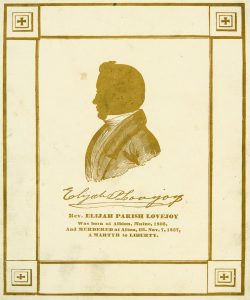
Elijah Parish Lovejoy (November 9, 1802-November 7, 1837) was a Presbyterian minister, journalist, and devout abolitionist. He was born near Albion, Maine, to Elizabeth and Daniel Lovejoy and was the eldest of nine children. His father being a preacher for a local congregation and his mother being highly religious gave Lovejoy exposure to the Christian faith and set him up on a path towards work in the religious hierarchy. As a teenager, he attended Waterville College (what is now Colby College) and did exceptionally well.
After college, Lovejoy moved to St. Louis, Missouri, a location fractured by slavery. Here he operated a school designed to emulate teaching styles in the East. However, once local editors started including his works in the papers, he began to stop teaching a turn towards a life of journalism. For about five years Lovejoy worked at the St. Louis Times and later became an editor of the St. Louis Observer. Afterwards, he would turn back towards religion and attend Princeton Divinity School to become a Presbyterian preacher.
After divinity school, Lovejoy returned to St. Louis and started a Presbyterian church while also resuming his work at the St. Louis Observer. At this time he began to write editorials criticizing slavery. Lovejoy became deeply critical of slavery and these views were reflected in his newpaper. However, the residents of Missouri did not all share this sentiment. After Lovejoy’s printing press was destroyed three times by slavery supporters, Lovejoy decided to move his paper to the free state of Illinois.
In May of 1836, Lovejoy moved to Alton, Illinois. Here his anti-slavery drive became stronger. He created the Alton Observer, an abolitionist paper. Additionally, he started a movement for an anti-slavery society. However, the residents of Alton were not pleased with this surge against slavery. Although Illinois was a free state, it was also a popular location for slave-catchers and pro-slavery organizations. Additionally, the city of Alton had begun to undergo financial hardship in the late 1830s. Residents questioned if this trouble was in part due to Lovejoy’s abolitionist movements. Many cities in the south, whose economy depended on slavery, were now refusing to engage in trade and buisness with Alton. As such, the pro-slavery residents of Alton grew to strongly dislike Lovejoy.
This disliking hit its climax on November 7th, 1837 when a pro-slavery mob set fire to Lovejoy’s printing press. Escaping the flames, Lovejoy and his employee’s were forced out of the press and they were shot at. Lovejoy was hit five times and killed on sight. Additionally, the printing press was destroyed.
This incident made Lovejoy a martyr for the abolitionist movement. Not only was he referred to as “the first casualty of the Civil War,” but many anti-slavery movements were created in his honor. In particular, a fellow abolitionist, William Lloyd Garrison, started the New England Anti-Slavery Society. He called for non-violent protest against slavery. One of his first followers, Bronson Alcott, took this message to heart and brought the idea of nonviolent resistance to Concord with his refusal to pay taxes. Thoreau soon adopted the idea of peaceful protest and later stopped paying his taxes himself, eventually sparking the beginning of his famous essay “Civil Disobedience.”

